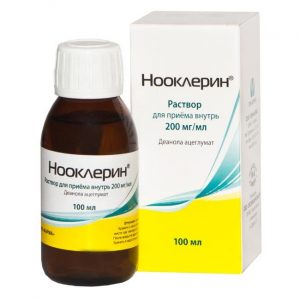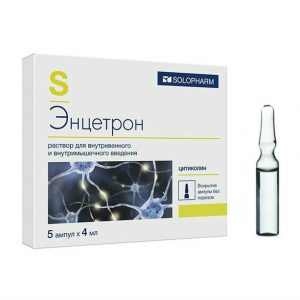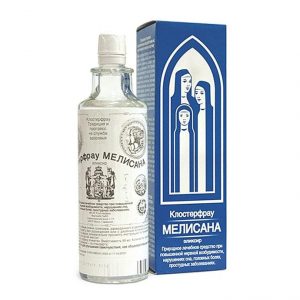Description
Release form
Tablets
Packing
30 pcs.
Pharmacological action of
Solian is an antipsychotic drug (antipsychotic)
Pharmacodynamics
Amisulpride binds selectively with high affinity to D2 / D3 subtypes of dopaminergic receptors, while it does not have D5 affinity for D1.
Unlike classical and atypical antipsychotics, amisulpride has no affinity for serotonin, histamine H1, alpha-adrenergic and cholinergic receptors. In addition, amisulpride does not bind to sigma sites. When used in high doses, it blocks postsynaptic D2 receptors localized in limbic structures, in contrast to similar striatum receptors. It does not cause catalepsy and does not lead to the development of hypersensitivity to D2-dopamine receptors after repeated treatment.
In low doses, it predominantly blocks presynaptic D2 / D3 receptors, causing the release of dopamine, which is responsible for its disinhibitory effects. Such an atypical pharmacological profile may explain the antipsychotic effect of amisulpride at high doses resulting from blockade of postsynaptic dopamine receptors and its effectiveness against negative symptoms at low doses as a result of blockade of presynaptic dopamine receptors.
In addition, amisulpride is less likely to cause extrapyramidal side effects, which may be due to its predominant limbic activity.
In patients with acute schizophrenia, Solian acts both on secondary negative symptoms and on affective symptoms, such as depressed mood and retardation.
Pharmacokinetics of
Amisulpride has two absorption peaks: one is reached quickly, one hour after the dose, and the second between 3 and 4 hours after administration. The plasma concentration, respectively, is 39 ± 3 and 54 ± 4 ng / ml, after taking 50 mg.
Distribution volume is 5.8 l / kg. Since plasma protein binding is low (16%), interaction with other drugs is unlikely.
Absolute bioavailability is 48%. Amisulpride metabolizes poorly: (about 4%, two inactive metabolites have been identified. Amisulpride does not accumulate and its pharmacokinetics remain unchanged after repeated doses.
The half-life (T1 / 2) of amisulpride is approximately 12 hours after an oral dose.
Amisulpride is excreted unchanged in the urine. Renal clearance is approximately 20 l / h or 330 ml / min.
A carbohydrate-rich food (containing 68% liquid) significantly reduces AUC (the area under the concentration / time curve), the time to reach the maximum concentration and the maximum concentration of amisulpride itself, but there have been no changes in the pharmacokinetics after eating fatty foods. However, the significance of these observations in everyday clinical practice is unknown.
Hepatic failure. Due to the fact that the drug is poorly metabolized, there is no need to reduce the dose for patients with impaired liver function.
Renal failure. T1 / 2 in patients with renal failure does not change, but the systemic clearance decreases with a coefficient from 2.5 to 3. The AUC of amisulpride doubles with small renal failure, and almost ten times with moderate failure (see section Dosage and Administration). Practical experience, however, is limited, and there are no results on the use of doses in excess of 50 mg.
Amisulpride is poorly dialyzed.
A limited number of pharmacokinetic data for elderly (over 65 years) patients suggests that after a single oral administration of 50 mg of Cmax, T1 / 2 and AUC is 10-30% higher than in younger people. There are no data on the pharmacokinetics of the drug during long-term treatment.
Indications
Acute and chronic schizophrenia, accompanied by pronounced productive (including delusions, hallucinations, thinking disorders) and / or negative (including affective flatness, lack of emotionality and avoiding communication) disorders, including h in patients with a predominance of negative symptoms.
Contraindications
– Concomitant prolactin-dependent tumors (including pituitary prolactinoma, breast cancer).
– Pheochromocytoma.
– Severe renal failure (CC less than 10 ml / min).
– Combined use with suloprid.
– Combined use with dopaminergic agonists (including amantadine, apomorphine, bromocriptine, cabergoline, entacapone, lisuride, pergolide, pyribedil, pramipexole, quinagolide, ropinirole, selegiline), with the exception of patients with Parkins disease.
– Children under 14 years old.
– Lactation (breastfeeding).
– Hypersensitivity to amisulpride and other components of the drug.
Caution is advised to use the drug in: – Pregnancy.
– Epilepsy.
– Parkinsonism.
– Renal failure.
– In elderly patients.
Pregnancy and lactation
The safety of amisulpride during pregnancy has not been established. Consequently, the use of the drug during pregnancy is not recommended, unless the intended benefit to the mother justifies the potential risk to the fetus.
The use of amisulpride during lactation is contraindicated.
Special instructions
It is possible to develop a malignant antipsychotic syndrome, characterized by hyperthermia, muscle stiffness, peripheral nervous system dysfunction, and elevated CPK levels. With the development of hyperthermia, especially when used in high doses, all antipsychotic drugs (including Solian) should be discontinued.
Since excretion of amisulpride is carried out by the kidneys, in case of serious impaired renal function, the dose of the drug and the treatment regimen should be adjusted. There is no experience with the use of the drug in patients with severe impairment (CC less than 10 ml / min).
Since the drug is poorly metabolized, dose reduction is not required for impaired liver function.
Due to the possible reduction in the seizure threshold when using amisulpride, patients with a history of epilepsy need constant monitoring during therapy with Solian.
In elderly patients, amisulpride should be used with special precautions because of the possible risk of arterial hypotension or excessive sedation.
In Parkinson’s disease, caution is required when prescribing antidopaminergic drugs and amisulpride because of a possible worsening of the condition. Amisulpride should only be used if antipsychotic therapy cannot be avoided.
Amisulpride causes a dose-dependent prolongation of the QT interval, thereby increasing the risk of developing serious ventricular arrhythmias (such as pirouette). Before prescribing the drug, and, if possible, depending on the clinical condition of the patient, it is recommended to control factors contributing to the development of arrhythmia: bradycardia (heart rate less than 55 beats / min), hypokalemia, congenital lengthening of the QT interval.
In patients who require long-term treatment with antipsychotics, an ECG should be performed during the initial status assessment.
Due to the content of lactose in the tablets, the drug is contraindicated in congenital galactosemia, a syndrome of impaired glucose or galactose absorption, or in case of lactase deficiency.
Use for impaired liver function: When prescribing the drug to patients with impaired liver function, a dose reduction is not required.
Use for impaired renal function: The use of the drug is contraindicated in severe renal failure (CC less than 10 ml / min).
Influence on the ability to drive vehicles and control mechanisms: Amisulpride affects the reaction rate, as a result of which the ability to engage in potentially hazardous activities can be impaired.
Composition
1 tablet contains: active substance: amisulpride 200 mg,
excipients: potato starch, lactose, monohydrate, methyl cellulose, colloidal aqueous silicon dioxide, magnesium stearate
Dosage and administration of
In acute psychotic episodes, the recommended dose is 400 to 800 mg / day. In some cases, if necessary, the dose can be increased to 1200 mg / day. Doses are increased taking into account the individual tolerance of the drug. The maximum daily dose should not exceed 1200 mg.
In case of mixed negative and productive symptoms, the doses should be selected so as to provide optimal control over the productive symptoms: on average, from 400 mg to 800 mg / day. Supportive treatment should be set individually at the minimum effective dose level.
Recommended daily dosage varies from 50 to 300 mg. Selection of doses should be individual.
Olian patients should be given special care with Solian because of the possible development of arterial hypotension or excessive sedation.
In doses exceeding 400 mg / day, Solian should be prescribed in 2 divided doses.
Side effects
Side effects are presented in accordance with the following gradations of their frequency of occurrence: very often (> 10%), often (> 1%, 0.1%, 0.01%,
The side effects are listed below, observed in controlled clinical trials and with post-marketing use of the drug. It should be noted that in some cases it is very difficult to differentiate side effects from the symptoms of the underlying disease.
From the nervous system: very often – extrapyramidal symptoms (tremor, rigidity, hypokinesia, hypersalivation, akathisia, dyskinesia). These symptoms are usually mild when taken in optimal doses and partially reversible when anticholinergic antiparkinsonian drugs are added without discontinuing treatment with amisulpride. The incidence of extrapyramidal symptoms is dose dependent. Therefore, in patients with predominantly negative symptoms, taking amisulpride in a dose of 50-300 mg, the incidence of extrapyramidal disorders is very low often – acute dystonia (spasmodic torticollis, oculogyric crises, trismus), reversible with the addition of anticholinergic antiparkinsonian drugs without stopping treatment with amisulpride, daytime drowsiness infrequently – late dyskinesias, characterized by rhythmic, involuntary muscles or mainly movements usually arising after prolonged use of the drug. Anticholinergic antiparkinsonian drugs in these cases are ineffective or may increase the symptoms of seizures, an unknown frequency – malignant antipsychotic syndrome (see. “Special instructions”).
From the gastrointestinal tract: often – constipation, nausea, vomiting, dry mouth.
From the endocrine system: often – amisulpride causes an increase in plasma concentrations of prolactin, reversible after discontinuation of the drug. This can lead to galactorrhea, amenorrhea, gynecomastia, pain in the mammary glands and erectile dysfunction.
Metabolic disorders: often – increased body weight infrequently – hyperglycemia (see “Contraindications,” With caution “and” Special instructions “).
Disorders of the cardiovascular system: often – arterial hypotension infrequently – bradycardia unknown frequency – lengthening of the QT interval ventricular rhythm disturbances, such as polymorphic ventricular tachycardia of the pirouette type (torsade de pointes), which can turn into ventricular fibrillation and lead to cardiac arrest and sudden death (see “Special Instructions”) of thromboembolism, including pulmonary embolism, sometimes fatal and deep vein thrombosis (see “Special Instructions”).
On the part of laboratory parameters: infrequently – an increase in the levels of liver enzymes, mainly transaminases.
From the side of the immune system: infrequently – allergic reactions.
Others: often – insomnia, anxiety, agitation, orgasm disorders, frigidity.
Drug interactions
Combinations that are contraindicated: With dopaminergic agonists (including amantadine, apomorphine, bromocriptine, cabergoline, entacapone, lisuride, pergolide, pyribedil, pramipexole, quinolinol, sickinolide, quinolinol, sickinolide, pinolinolide, sickinolide, . Dopaminergic agonists and antipsychotics exhibit mutual antagonism. With extrapyramidal syndrome caused by antipsychotics, anticholinergics should be used instead of dopaminergic agonists. With the simultaneous use of Solian with sultopride, the risk of ventricular arrhythmias, especially atrial fibrillation, is increased.
Combinations that are not recommended: With drugs that can cause arrhythmias such as pirouette: Class Ia antiarrhythmic drugs (including quinidine, hydroquinidine, disopyramides) and class III (including amiodarone, sotalol, dofetilide, ibutilide), some antipsychotics (including thioridazine, chlorpromazine, levomepromazine, trifluoperazin, cyamemazine, sulpiride, tiapride, pimozide, haloperidol) and other droperid drugs (including bepridil, cisapride, difemanil, iv erythromycin, misolastin, iv vincamine, halofantrine, sparfloxacin, gatifloxacin, moxifloxacin, pentamidine, iv spiramycin). The risk of ventricular arrhythmias increases, especially the development of arrhythmias such as pirouette. If the combination of drugs cannot be avoided, before the appointment, monitor the QT interval and begin monitoring the ECG. Ethanol enhances the sedative effects of antipsychotics. Avoid the consumption of alcohol and the use of medicines containing alcohol. Mutual antagonism of the action of levodopa and antipsychotics when prescribing these drugs should be taken into account. In patients with Parkinson’s disease, the minimum effective dose of both drugs is recommended.
Combinations requiring special care: With drugs that cause bradycardia (including beta-blockers / except sotalol / calcium channel blockers that cause bradycardia – diltiazem and verapamil), clonidine, guanfacin, digitalis preparations, and choline inhibitors. including donepezil, rivastigmine, tacrine, ambenonium, galantamine, pyridostigmine, neostigmine). With drugs that can cause hypokalemia (including potassium-excreting diuretics, laxatives, iv amphotericin B, glucocorticoids, tetracosactides). With the above combinations of drugs, there is a risk of ventricular arrhythmias, especially the development of arrhythmias such as pirouette.
Combinations to be taken into account: With antihypertensive agents and beta-blockers in heart failure (including bisoprolol, carvedilol, metoprolol) has a vasodilating effect, increasing the risk of orthostatic hypotension (additive effect). With morphine derivatives (including analgesics, antitussive drugs), barbiturates, benzodiazepines and other anxiolytics, hypnotics, sedative antidepressants (including amitriptyline, doxepin, mianserin, mirtazapine, trimipramine), sedative antihistamines central action, antipsychotics and other drugs (including baclofen, thalidomide, pisotifen) leads to a marked increase in the inhibitory effect on the central nervous system (attention spans and danger to transport drivers and machine operators).
overdose Symptoms: The experience with overdose of amisulpride is very limited. A significant increase in the known pharmacological effects of the drug has been reported, namely, the development of drowsiness, sedation, coma, arterial hypotension and extrapyramidal symptoms.
It should be borne in mind that the effects of overdose can occur in cases of mistaken administration of additional doses of the drug or simultaneous administration of other drugs.
Treatment: There is no specific antidote for amisulpride.
In case of overdose, the basic vital functions of the body should be monitored and maintained until the patient completely leaves the overdose state. In case of overdose, ECG monitoring is mandatory, since there is a risk of prolonging the QT interval and the development of life-threatening rhythm disorders (see Side Effects ).
In case of severe extrapyramidal symptoms, anticholinergic agents should be used.
T.k. elimination of amisulpride by hemodialysis is insignificant, it is impractical to remove it with an overdose with hemodialysis.
Storage Conditions
The product should be stored in a dry place at temperatures below 25 ° C.
Shelf life
3 years.
Deystvuyushtee substance
Amisulyprid
Terms and conditions
prescription
drug vennaya form
Possible product names
SOLIAN 0.2 N30 TABLE
SOLIAN 0.2 N30 TABLE P / O
Solian 200mg tab. X30
Solian 200mg Tab. X30 /! Until 01.14g /
Solian 200mg No. 30
Sanofi-Aventis, France




